The next revolution was to provide remote entertainment to the listeners at home by the means of broadcasting. This initially impacted on silent films until cinemas were able to present movies with sound. The Perth airwaves were then populated by a variety of commercial and ABC radio stations.
The advent of wireless opened up additional opportunities for musicians and singers, with many theatre trained voices proving popular as announcers when in 1924, Western Farmers Limited (Wesfarmers) began operating radio station 6WF from the top floor of the company’s Wellington Street building. The transmitter was located on the roof of the building. Wesfarmers also manufactured and sold the ‘Mulgaphone’ radio receivers. Within the first month of operation the sealed set system was abandoned by the government and the Mulgaphones were re-designed, making it possible to receive stations in wavelengths within the range of 250 metres (1200 KHz) to 2000 metres (150 KHz).

During the radio era music tastes changed radically and the nature of programming altered considerably. Before the introduction of television, radio evenings were more like TV without the pictures, for there were the dramatic serials, comedy and quiz programs. Radio serials in Australia date back to the 1930s, though many of Australia’s greatest radio serials were produced during the 1940s, as radio reached its boom stage. In the late 1940s and early 1950s, possibly the most popular programs were those of a frantically adventurous nature aimed at a younger audience.
Many halls have been build in Perth since colonial day, which provided a venue for all manner of social activity and entertainment. The Rechabite’s Hall, located at 224 William Street in Northbridge, was purpose built for the Independent Order of Rechabites in 1924, one of 15 friendly societies that have been registered in Western Australia, which had a large following during the early decades of the 20th century and continues with smaller numbers. The Rechabite’s Hall played a significant role in the social life of Northbridge, as a venue for balls, dance exhibitions, church services, conferences, annual meetings, school productions and an election polling station.
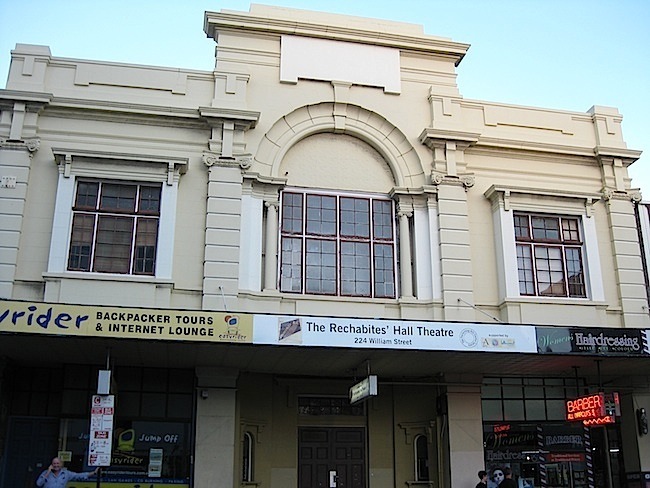
The upper level and foyer of The Rechabites’ Hall was leased to The Perth Theatre Trust between 1986 and 2009. From 1997 – 2008, The Hall operated as a 140-seat, arena style theatre converted from an Edwardian dance hall, under the management of the Performing Arts Centre Society, (the managing body of The Blue Room Theatre), on behalf of The Perth Theatre Trust. The Hall remained unaltered until it was sold in 1947 to The Commonwealth Bank. The bank vacated the building in 1978 and Multiplex took over the space as a site office for the construction of the Alexander Library. The Performing Arts Centre Society, trading as The Blue Room, ceased management of The Hall on 31 March 2009.
Performances that were presented through the Rechabites’ included cabaret; mono-drama; stand-up; music theatre; independent film screenings; contemporary and classic texts; dance; magic and buffoon. It was the setting for edgy, alternative theatre.
In 1926, the silent movie industry in the United States was declining due to radio, and the increasing popularity of recorded music in the form of gramophone records, which offered something that the movie theaters lacked at the time – sound. People no longer had to leave their homes for entertainment and could enjoy music, comedy, or drama simply by tuning in or playing a record.
In 1927, the historian and foundation member of the Senate of the University of Western Australia, William Somerville, conceived the idea of a venue defined by a cathedral of Norfolk pine trees. The outdoor Somerville Auditorium will accommodate 1000 patrons on deckchair-style seats as well as 200 grass seats. Today the venue is best known for the Perth International Arts Festival’s Lotterywest Film Season from November through to April each year. The venue is also renowned for the annual In the Pines music festival organised by local community radio station RTR FM.

The Ambassadors, in central Hay Street, was opened in 1928, being based on a grand, spanish style atmospheric theatre in America, the Riveria in Omaha, Nebraska, which opened in 1927, one year before the Ambassadors, and is now preserved as the Rose Blumkin Performing Arts Theatre.
Additional venetian and roman elements were incorporated in the design of the Ambassadors, with the theatre interior designed to evoke a romantic courtyard, with a ceiling lit to imitate a star studded night sky, as if the audience were seated in an open-air garden, surrounded by exotic plants and birds.
The theatre also featured a Wurlitzer organ, which would rise from the floor to entertain moviegoers, before the screening commenced. A band also performed from the orchestra pit, and there were stage shows.
The orchestra was dispensed with in 1931 and the exterior redesigned in “moderne” style in 1938, a late type of the Art Deco design.
The organ was replaced in 1946, by a white grand piano that had a decorative role.
The Ambassadors closed on 4 February, 1972, and was demolished soon afterwards.
Ambassadors a Lost Cinema Heritage
WA TV History
The black and white film was taken by the late Ken Alexander (former projectionist, cine cameraman and TVW film editor). The film was provided courtesy of Barry Goldman, a friend and colleague of Ken Alexander. The narrator is former TVW and ABW host and reporter John Hudson. The colour photos come from the collection of cinema pioneer, the late Ron Tutt.
The Prince of Wales was one of the two cinemas to introduce sound films to Perth on 6 April 1929, while the Regent screened The Red Dance (1928) using variable density sound-on-film, which contained music and no recorded dialogue, the Prince of Wales presented Warner’s The Jazz Singer (1927), using the Vitaphone sound-on-disc, though this movie was mostly silent, with segments of recorded dialogue and lip sync songs. The quality of the the sound-on-disc was then superior to the early sound-on-film, though this was to change with the development of variable area sound-on-film.
Al Jolson (1886–1950) was the star of The Jazz Singer in 1927, who at that time was dubbed “The World’s Greatest Entertainer”, for between 1911 and 1928 he had more than 80 hit records, and 16 national and international tours. His music was to influence the style of Bing Crosby, Judy Garland and many more.
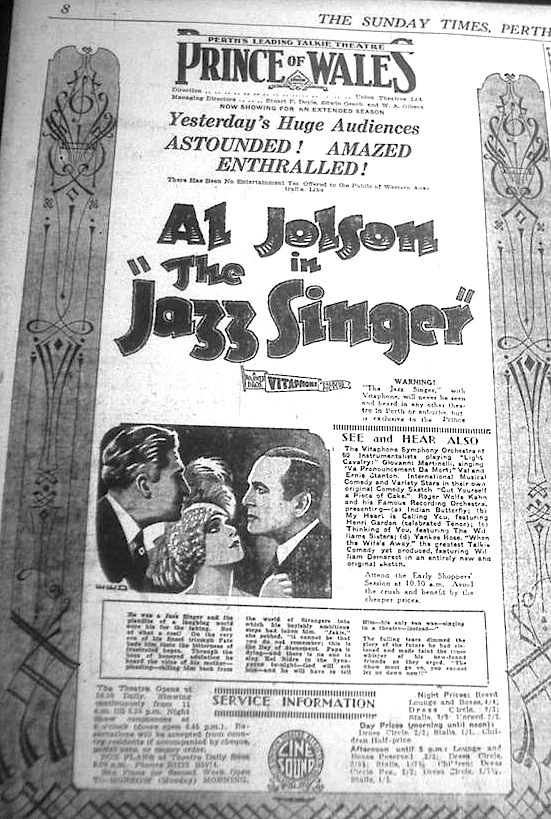
Al Jolson the star of The Jazz Singer in 1927
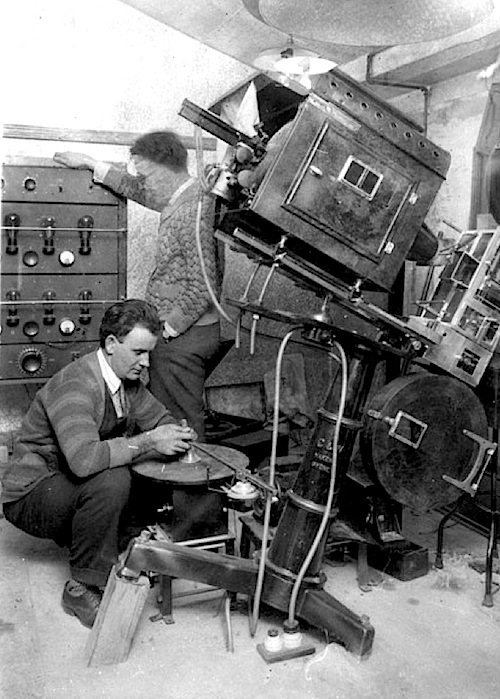
Setting up the turn-table for the first “talkies” in Australia
The Jazz Singer (1927)
The son of a Jewish Cantor must defy his father in order to pursue his dream of becoming a jazz singer. – The Jass Singer was the first feature-length motion picture with synchronised dialogue sequences, but even though the film was only eighty-nine minutes long… there were fifteen film reels and fifteen sound discs to manage. The projectionist manually synced each of the reels to its own phonograph record containing dialogue and music. Much of the film was presented as a silent movie without spoken dialogue, using written captions to convey the words, as this excerpt illustrates.
At the beginning of sound movie era there were two competing and incompatible sound systems. The Vitaphone process was cumbersome, relying on an mechanical interface between the projector and the turntable. Fox’s Movietone sound-on-film process was less accident prone, escaping the many operator errors with sound-on-disc, though required a costlier projector. By 1933, the Vitaphone system had lost popularity, but they still supplied discs until 1937, when the optical sound-on-film system won out. Meanwhile, The Prince of Wales theatre closed permanently in 1935.
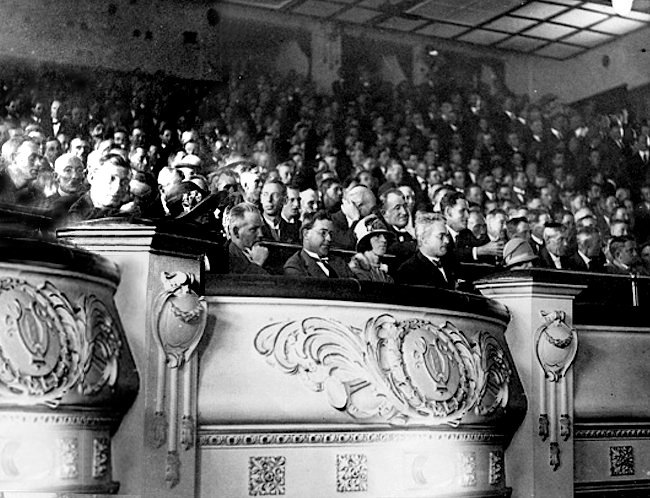
Prince of Wales dress circle
The theatre’s namesake in 1922 was Edward, the son of King George V of the United Kingdom, who briefly was King from 20 January to 11 December 1936. He abdicated the throne to marry the American divorcee, Wallis Simpson and then lived in exile as the Duke of Windsor. His romance with Mrs Simpson was well developed by the time the theatre closed in 1935, during the Great Depression which lasted until the start of World War II.
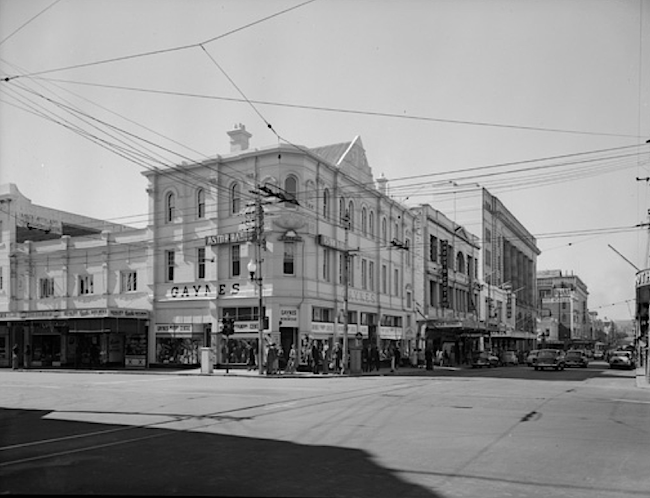
The corner of William and Murray Streets
The Prince of Wales Theatre was located between the Gaynes menswear store on the corner of William and Murray Streets and the Bairds department store, before Bairds demolished both buildings to contruct a modern new store on that corner.
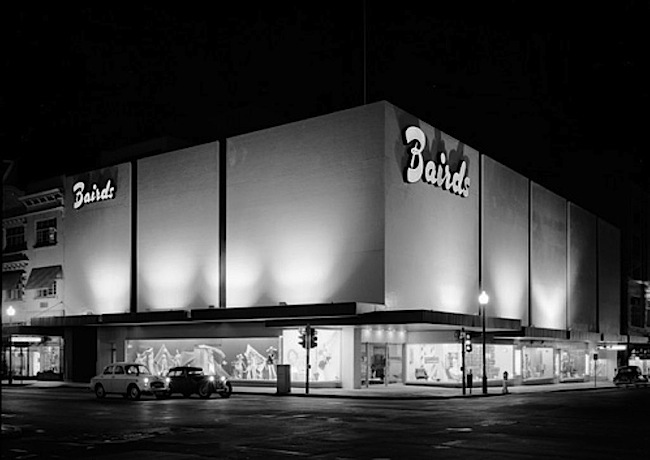
Bairds Store on the corner of William and Murray Streets
The Bairds department store was later was taken over by Myer, before taking over Boans and demolishing that too, to construct the existing Myer Perth store.
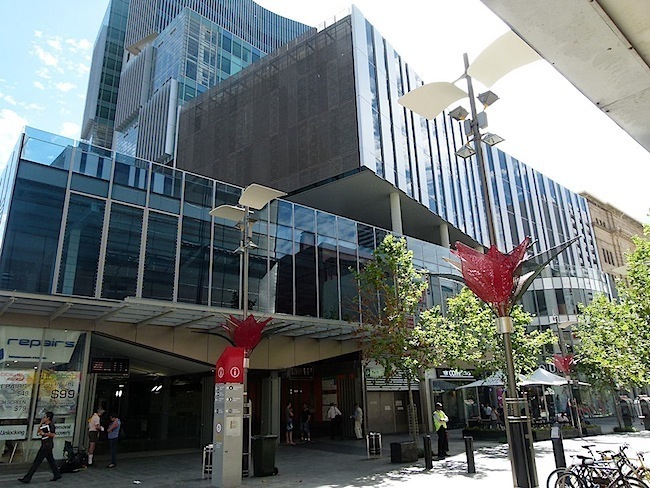
This corner has now been completely redeveloped and is positioned above the underground rail station. The site currently comprises three office towers above two levels of retail, dining and entertainment. The large scale development weaves fully-restored, existing heritage buildings into its design. On Wellington Street theres the Wellington Building, the original Globe Hotel and the Bairds Building, along with the facade of the Mitchell Building on William Street. The former Commonwealth Bank building (completed in 1933) is the only surviving structure found in the vicinity of that corner on Murray Street.
Not only was entertainment technology making advances, but music was also making a transition. Lyrics were being liberated from the 1920s on, with Ragtime flowing onto Jazz, which dominated the counter-culture of the roaring twenties. Blues was also popular by the 1920s, and highly influenced the Jazz Age.
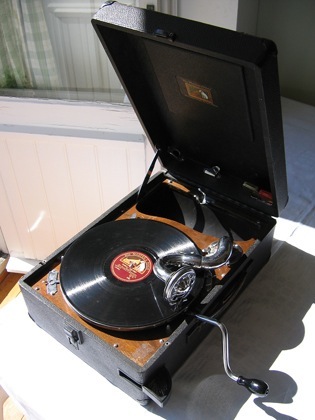
Then a branch of jazz called Swing in the 1930s influenced dance with the Jitterbug and the big band show-band music of Benny Goodman carried on into the 1940s. Other prominent band leaders and their orchestras were Glenn Miller, Tommy Dorsey, Guy Lombardo and the Royal Canadians. It was a time when the music was generally accepted by old and young alike, until Rock ‘n’ Roll alienated the elderly. Radio, recorded music and movies were to help mould the music listening culture. But until then, live performance still had a life in entertaining the masses who could afford the tickets.
Followed the end of World War I, female dress fashion changed in the 1920s with a movement away from the long dresses to the short skirts of the “flappers” who flouted social and sexual norms. By the 1930s, this liberalism was reflected by a number of movies such that the National Legion of Decency and the Production Code of 1934 was introduced in the US. This impacted on the risque humour, tendency to show ample flesh and sexual innuendos of artists such as Mae West (1893–1980) and the Betty Boop cartoons.
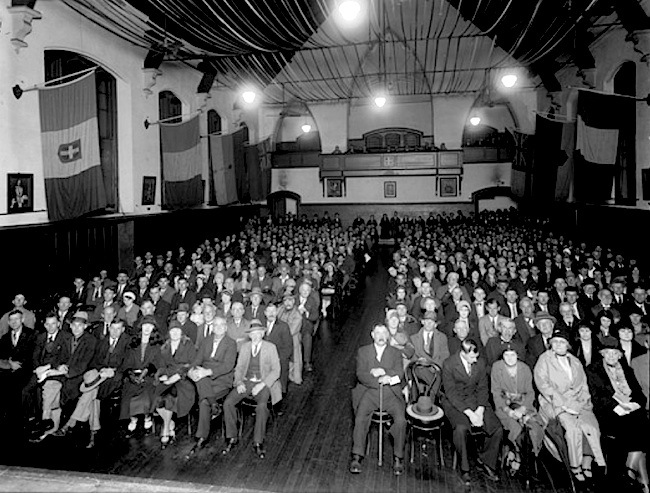
The Perth Symphony Orchestra was established in 1928 and performed many concerts in the Queens Hall (later the Regent theatre before morphing into the Metro theatre) and Perth Town Hall, of which some were broadcast on radio station 6WF. A smaller group, the Western Studio Orchestra was formed by the ABC in 1932, to then be known as the Perth Symphony Orchestra in 1937. The orchestra was named the West Australian Symphony Orchestra in 1950.
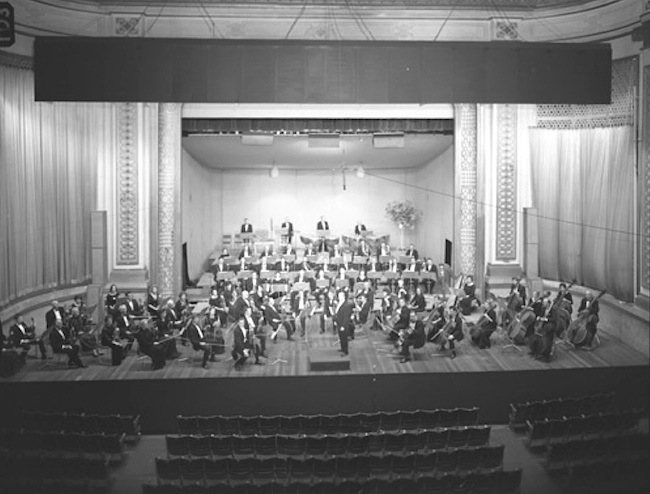
The finely decorated Capitol Theatre opened in 1929 where the lounge foyer featured a bust of the great silent star Rudolph Valentino, and legend has it that the bust’s lips were constantly red with the adoring but heartbroken kisses of his Perth fans. The bust is today part of the WA Performing Arts Museum collection at His Majesty’s Theatre. Though initially a cinema, with the advent of television, the Capitol confined itself to orchestral concerts and other stage shows until its demolition in 1967.
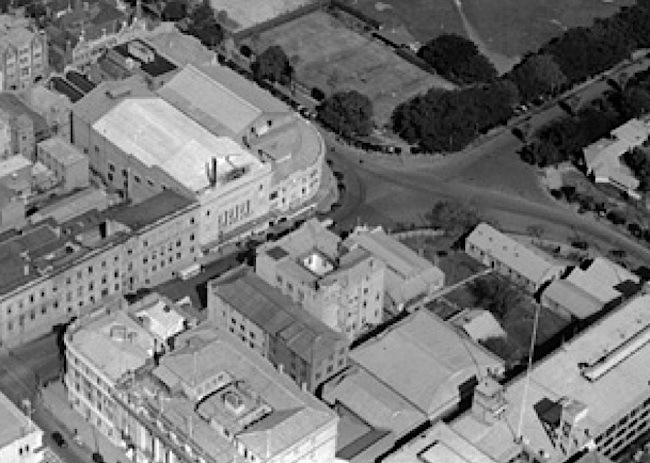
The Capitol Theatre near the corner of William Street and The Espanade
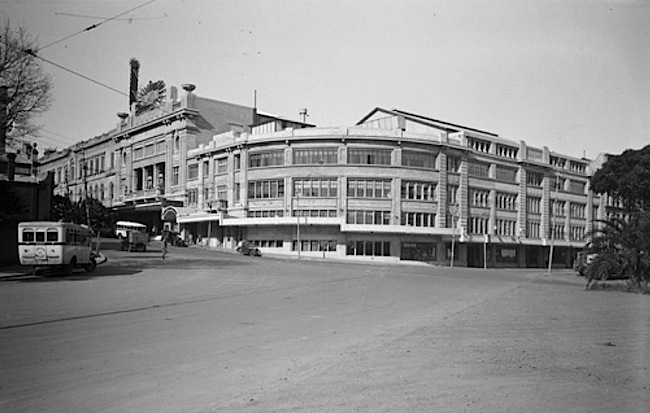
Capitol Theatre and Temple Court
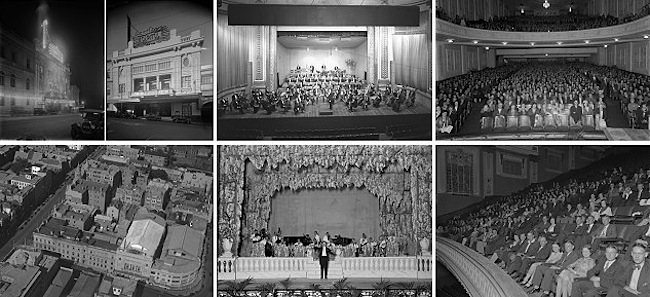
The 2,250 seat Capitol Theatre functioned as a live theatre and cinema
As a live theatre, its stage was graced by some of the 20th century’s legendary performers, including Noel Coward, Vivien Leigh and Sir Lawrence Olivier.
At the base of William Street next to the Capitol theatre was Elder House which occupied Temple Court. This building also housed the Embassy Ballroom, a popular dance hall.
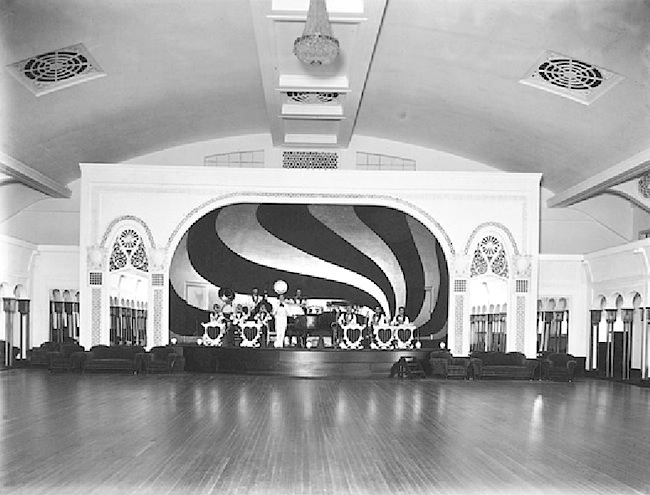
It was a time when our culture was undergoing a radical change, largely driven by new technology as we moved away from the horse and cart into mass entertainment through the cinema and the ever increasing number of radio stations.
In 1929, radio station 6WF was taken over by the Australian Broadcasting Company and moved from the Wesfarmers building to the English, Scottish and Australian Bank (E.S. & A.) building at the corner of Hay and Milligan Street, Perth. It was an an A-class radio station funded by listener licence fees.
In 1930, Musgroves Limited opened their station 6ML (on 19th March 1930) with Clarence Serl as the engineer. The transmitter was housed on the top floor in a screened room, with its a long wire antenna strung from the top of Musgroves limited to the top of the Post office building.
In 1931, Radio Station 6PR begins broadcasting via the Applecross Wireless Station. 6PR was then owned by Nicholson’s Limited, with studios located on the the second floor of their music shop at 86 Barrack Street, Perth. Later the 6PR transmitter move down to Alfred Cove on the Swan River, then when that site was demolished they joined 6PM on their former mast at Coffee Point, opposite the South Perth Yacht Club. Since the demolition of that transmitter site, 6PR has joined ABC radio at the Hamersley transmitter site. 6PR’s original broadcast frequency was 880 kHz – a position that it stayed at until 1978 when it moved slightly up the dial to 882 kHz with the advent of 9 kHz spacing on the AM dial. The station still broadcasts on that frequency today.
In 1932, the Garrick Dramatic and Repertory Club was founded in Guildford, which still continues to this day as the Garrick Theatre Club Inc.
In 1932, the Australian Broadcasting Commission Act was passed, following which The Australian Broadcasting Commission took over the premises from the Australian Broadcasting Company, and the 6WF transmitter was relocated to Wanneroo (now called Hamersley).
Built in 1932 on the University of WA site, Winthrop Hall looks like a marble cathedral. It has an auditorium whose acoustic structure is ideal for holding classical and choral music. It has been a venue often used by the ABC for the broadcast of serious music works.
In 1933, the W.A. Broadcasters Ltd owned 6IX was officially opened on the 27th November with its first studios situated above the Musgroves shop, known as Lyric House, Murray Street, Perth. The transmitter: was located on the roof of Newspaper House in St. George’s Terrace, Perth. The service was broadcast on a wavelength of 242 metres or 1240 kilohertz at a power of 500 watts.
Meanwhile, live theatre was being fostered at the community level by a wide range of groups that were spread far and wide. For example, The Roleystone Theatre had its beginnings in the 1930s as a choral and amateur dramatic society, has evolved since the 1970s into a group which puts on plays and musicals. They produce, on average, five major shows every year in a heritage listed art-deco style auditorium.
With the advent of sound with the movies and the spate of musicals which flourished through into the 1950s, light classic music such as late 19th century operettas proved popular as did that featured in the Broadway and London West End shows. Popular not only in the cinema but on radio too. Two stars of the light classic genre were soprano Jeanette MacDonald (1903–1965) and baritone Nelson Eddy (1901–1967). They became “America’s Singing Sweethearts” of the 1930s and starred in classic movies like Naughty Marietta, Rose Marie, Maytime, New Moon, in live opera, on radio and in early television. MacDonald recorded more than 90 songs during her career whilst Eddy made more than 290 recordings. Their movies were still being screened in Perth in the 1950s with Eddy making four tours of Australia, appearing in Perth at the Capitol Theatre.
Another star to sing classics was Deanna Durbin (1921-) who by the age of 21 was the highest-paid woman in the United States and highest-paid female film star in the world. She appeared in a number of musical films in the 1930s and 1940s singing standards as well as operatic arias.
In 1937, the art deco Plaza cinema opened, seating 1,313. It was located above the Plaza arcade. The theatre was renamed the Paris in 1965 and finally closed in 1984. The building still exists and is heritage listed, though access to the auditorium is now restricted to the fire escape from a rear entrance on a lane-way, midway down the arcade.
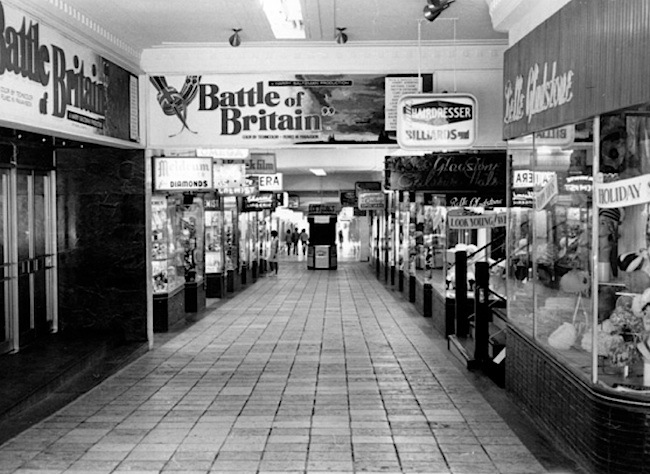
In 1937 the ABC moved its studios and staff to St Georges Terrace, located on the edge of the Supreme Court Gardens, next to the Government House Ballroom. The building was then called ‘Broadcast House’.
Also in 1937, 6PM became Perth’s third commercial radio station (launched on April 22, 1937 on the frequency 1000 kHz) transmitting from a site in Palmyra and stayed there until they was moved to a transmitter site at Coffee Point in 1942, on the south side of the Swan River, near the South of Perth Yacht Club, after approaches to the prime minister John Curtin were made to shift to this site. The company directors were Frank Whitford, Perth (Managing) and his brother Archer Whitford, who lived in Sydney. The first studios were located at 23 William Street, Perth, which was where Whitford’s theatre advertising and photographic theatre slide making was conducted. Both 6PM and 6AM broadcast from this building until they moved to St. George’s House, 115 St Georges Terrace in 1953. Whitford Broadcasting Network came to comprise 6PM Perth, 6AM Northam, 6KG Kalgoorlie and 6GE Geraldton. 6GE
In 1939, the Patch Theatre Guild and Dance School was founded in Perth by Edward and Ida Beeby. The theatre operated for many years in Murray Street, then William Street before setting in Victoria Park.
The Piccadilly theatre opened in 1939, located in central Hay Street.
With the outbreak of the Second World War, technology made enormous advances, which was reflected in the new ways the public were informed.
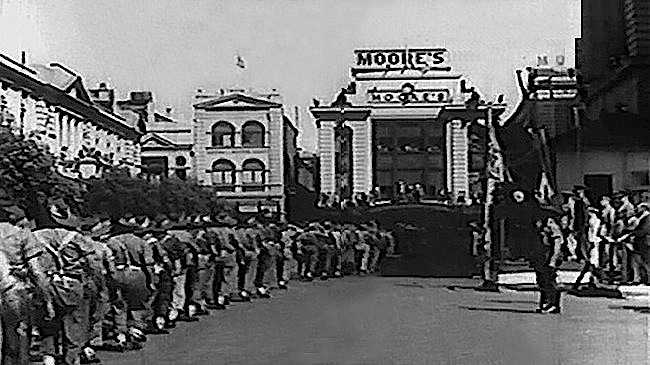
The filmmakers turned their attention to news reporting, which continued as a popular cinema feature until the introduction of daily television news bulletins. Southern Cross Newsreel’s ‘Westralian News’ being one, with cine cameraman Leith Goodall, the father of television veteran news cameramen Peter and Michael Goodall.
Making a presence at this time was Jane Powell (1929-) an American coloratura soprano who started her career singing on the radio before age 13. She was also a dancer and actress who had a successful career in movie musicals in the 1940s and 1950s and appeared regularly on US television, with guest spots on most of the top variety shows during the 1950s and 1960s. Shows which were shown on Australian television, such as The Perry Como Show, The Andy Williams Show, The Ed Sullivan Show, The Red Skelton Show, The Dinah Shore Show, The Dean Martin Show and The Judy Garland Show. Hosted mainly by singing personalities whose voices were heard often on recordings and Australian radio before the revolution of Rock and the Beatles.
In 1941, the newest station in town 6KY opened on 23rd October with a broadcast frequency of 1210 kHz – which was changed to 1206 kHz in 1978. Being the fourth commercial station in the city and the last one to open in Perth for the next 39 years. Its regional station 6NA Narrogin opened on 1951.
In 1943, 6ML merged into 6IX. 6ML went off the air on 30th May 1943, for an oversight in that someone forgot to pay their license. The 6ML studios were then taken over by W A Broadcasters who then held the license for 6IX (West Australian Newspapers Ltd.). The merged operation began transmission officially on 17th August 1943.
The middle aged and the elders were born in the century before and often clung to the values of that period, meanwhile the youngsters were growing up in an age of electricity, the motor car and the aeroplane… all impacted by the economic and political turbulence of the great depression and two world wars. The cinema, theatre and dance halls provided a refuge for many from the concerns of the day.
Richard Ashton provided much input and guidance in the compilation of this essay, Gordon McColl assisted in field trips and library research with Richard. Also appreciate the help provided by Dr Peter Harries, and Ian Stimson. Conversations with Coralie Condon, Audrey Long and Rick Hearder are highly valued, as they reminisced about the topic.
INDEX: Factors that moulded entertainment in Perth








Great information on this page. Just one correction, 6PR’s transmitter was relocated from Coffee Point to Ascot, adjacent to the Garrett Road bridge. It is co located with 6IX and has never been at ABC Hammersley.
Great info. I’m wondering how to get hold of higher resolution copies of some of the photos on this page as I believe a couple of them are of my grandfather?, He was in the orchestra of the Ambassador Theatre when it opened and played saxophone & violin in various bands around Perth until the 1940’s. If someone could let me know where I can find the pictures of the musicians from this page I would be very grateful. Thanks!